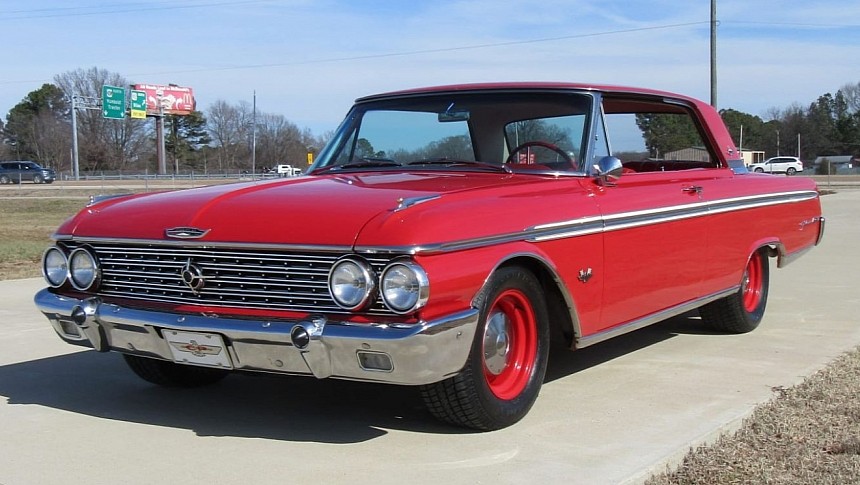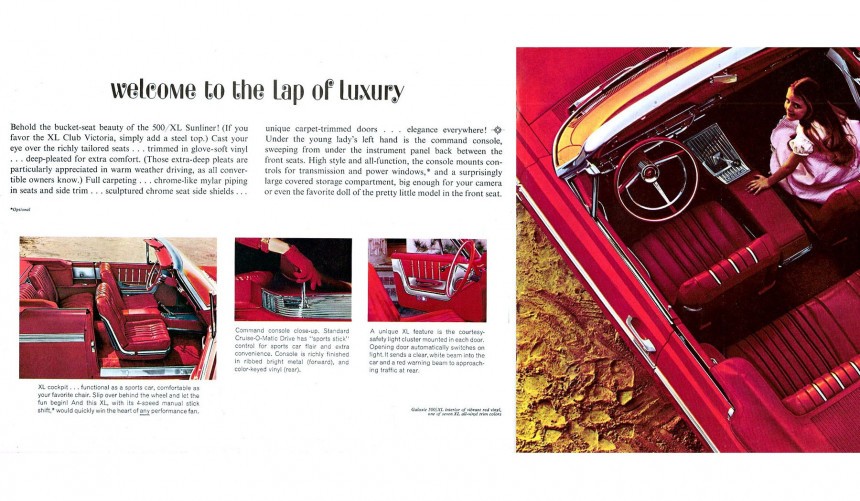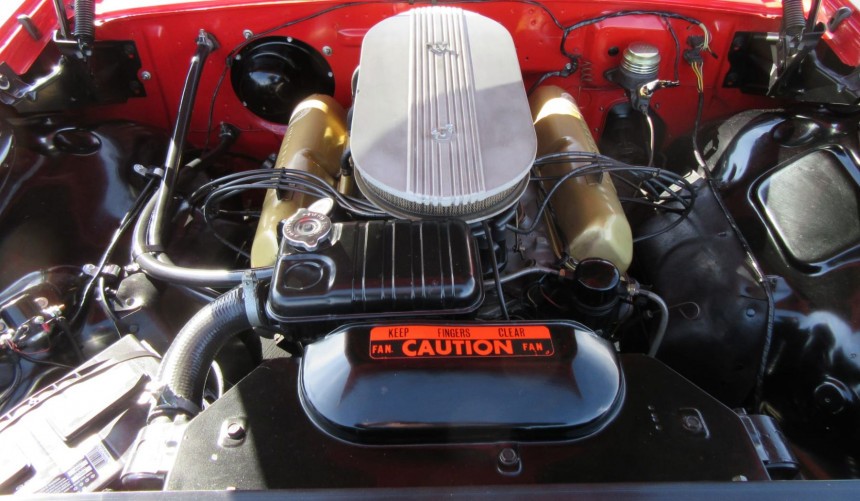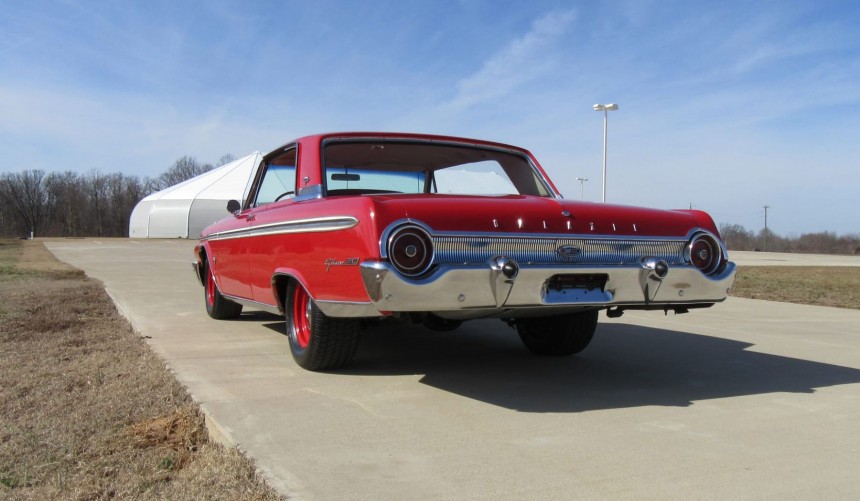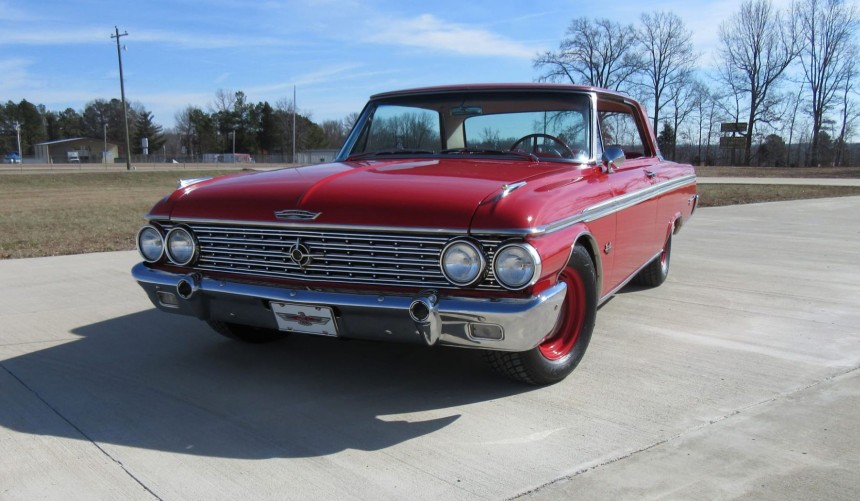The 1962 Galaxie 500XL 406 was Ford's first production car with a V8 larger than 400 ci (6.5 liters) and a direct rival for Chevy's iconic Impala SS.
With the 1950s in the rearview mirror, American carmakers realized that performance would become an essential ingredient for a successful sales recipe across all model lines during the next decade.
The first factory-built blue-collar performance model that would open the 1960s muscle car floodgates was Chevy's 1961 Impala SS.
Available with a potent 305-hp 348-ci (5.7-liter) V8 as standard or an even more powerful 360-hp 409 as an option, the Super Sport-equipped Impala became hugely popular among the growing performance crowd.
In the Blue Oval camp, the freshly redesigned Galaxie was available with a 401-hp "Thunderbird Special" six-barrel 390 (6.4 liters).
But, even if the optional engine offered more power, the absence of a sportier trim and the higher price meant that six-barrel 390-equipped Galaxies were no match for Chevy's Impala SS and its marketing campaign.
In 1962, Henry Ford II declared that the brand would shift its focus towards performance and adopt the "Total Performance" slogan. That meant motorsport dominance and the introduction of high-performance production models.
But, before that policy was implemented and became a full-fledged marketing campaign, Ford struggled to keep up with its rivals on the race tracks, drag strips, and dealerships.
To change that, the Blue Oval finally introduced its first 400-plus-cube V8 for both its motorsport programs and full-size street model.
The larger displacement motor and the sportier Galaxie 500 were the first steps towards bringing total performance to the showroom floor.
Besides adding the larger engine, Ford attempted to boost sales by launching a new marketing campaign called "Lively Ones."
This enabled potential buyers of the Galaxie 500 Club Victoria two-door hardtop coupe or the Galaxie 500 Sunliner two-door convertible to add the XL (Xtra Lively) option during the second part of the 1962 model year.
The option added upscale features such as individual front bucket seats, a center console complete with an armrest, full carpeting, or chrome trims, bringing a Euro GT feel to the sporty Glalaxie 500.
While the XL added more style to the sporty flagship, the biggest news of the model year for Blue Oval fans was the addition of the Thunderbird 406.
Conceived for NASCAR and NHRA (National Hot Rod Association) dominance, the new Thunderbird V8 was based on the 390 but featured larger bores and cross-bolted mains.
It was available only with the two-door hardtop coupe and convertible Galaxie 500s in two configurations.
The standard version of the 406-ci (6.6-liter) was equipped with a single Holley four-barrel carburetor that helped it make 385 hp.
If that wasn't enough, customers could opt for the 405-hp Super High-Performance (aka G-code) version that came with a trio of two-barrel carbs tucked under a shiny oval air cleaner.
In the latter configuration, the 406 enabled the Galaxie 500 to sprint from 0 to 60 mph (97 kph) in about 6.5 seconds - quicker than the Impala SS 409 and on par with Pontiac's newly-introduced Grand Prix 421 Super Duty.
Although the larger displacement engine highlighted the Galaxie 500's performance upgrades, the option included additional beefed-up hardware.
When buyers opted for either 406 configurations, their Galaxie 500 received a mandatory Borg-Warner T-10 four-speed manual, a beefier driveshaft, a new 9-inch rear axle, heavy-duty suspension, a larger radiator, four-wheel drum brakes, and 15-inch wheels.
Thanks to those upgrades and the 406 V8, the full-size Ford could consistently achieve quarter-mile runs in the mid-to-low 15s.
On the strip, a bone-stock Galaxie 500 wasn't as quick as some of its rivals due to its superior weight.
However, Ford tried to solve this issue with a special, drag-strip-oriented package that added a series of fiberglass panels and removed unnecessary features.
Though 164 pounds (74 kg) lighter than the standard model, the drag-strip-only Galaxie 500 failed to dominate rivals.
Consequently, sales of the 406-powered Galaxies didn't improve much, especially compared to similar models from GM or Chrysler brands.
Nevertheless, the mix of performance and style that defined the Galaxie 500XL was employed years later on muscle car legends like the GT-equipped Mustangs and Torinos.
An important step towards total performance, the 1962 Galaxie 500XL was only available with the 406 engine until the end of the 1963 model year, after which it was replaced with the legendary 427.
Although Ford discarded the sales records from that period, it's widely known that only a few Galaxie 500XLs received the 406 option.
As you can imagine, even fewer have survived in highly original shape. Nevertheless, the value for one rarely exceeds $35,000 these days.
This makes the 1962 Galaxie 500XL a bargain for Blue Oval fans who want to own one of the company's first, most influential high-performance models.
For more on this iconic Ford, we recommend watching the YouTube video below by Lou Costabile.
The first factory-built blue-collar performance model that would open the 1960s muscle car floodgates was Chevy's 1961 Impala SS.
Available with a potent 305-hp 348-ci (5.7-liter) V8 as standard or an even more powerful 360-hp 409 as an option, the Super Sport-equipped Impala became hugely popular among the growing performance crowd.
In the Blue Oval camp, the freshly redesigned Galaxie was available with a 401-hp "Thunderbird Special" six-barrel 390 (6.4 liters).
But, even if the optional engine offered more power, the absence of a sportier trim and the higher price meant that six-barrel 390-equipped Galaxies were no match for Chevy's Impala SS and its marketing campaign.
Bringing total performance to the showroom floor
But, before that policy was implemented and became a full-fledged marketing campaign, Ford struggled to keep up with its rivals on the race tracks, drag strips, and dealerships.
To change that, the Blue Oval finally introduced its first 400-plus-cube V8 for both its motorsport programs and full-size street model.
The larger displacement motor and the sportier Galaxie 500 were the first steps towards bringing total performance to the showroom floor.
Making the Galaxie 500 Xtra Lively
This enabled potential buyers of the Galaxie 500 Club Victoria two-door hardtop coupe or the Galaxie 500 Sunliner two-door convertible to add the XL (Xtra Lively) option during the second part of the 1962 model year.
The option added upscale features such as individual front bucket seats, a center console complete with an armrest, full carpeting, or chrome trims, bringing a Euro GT feel to the sporty Glalaxie 500.
The mighty Thunderbird 406
Conceived for NASCAR and NHRA (National Hot Rod Association) dominance, the new Thunderbird V8 was based on the 390 but featured larger bores and cross-bolted mains.
It was available only with the two-door hardtop coupe and convertible Galaxie 500s in two configurations.
The standard version of the 406-ci (6.6-liter) was equipped with a single Holley four-barrel carburetor that helped it make 385 hp.
If that wasn't enough, customers could opt for the 405-hp Super High-Performance (aka G-code) version that came with a trio of two-barrel carbs tucked under a shiny oval air cleaner.
In the latter configuration, the 406 enabled the Galaxie 500 to sprint from 0 to 60 mph (97 kph) in about 6.5 seconds - quicker than the Impala SS 409 and on par with Pontiac's newly-introduced Grand Prix 421 Super Duty.
The 406 wasn't the only performance upgrade
When buyers opted for either 406 configurations, their Galaxie 500 received a mandatory Borg-Warner T-10 four-speed manual, a beefier driveshaft, a new 9-inch rear axle, heavy-duty suspension, a larger radiator, four-wheel drum brakes, and 15-inch wheels.
Thanks to those upgrades and the 406 V8, the full-size Ford could consistently achieve quarter-mile runs in the mid-to-low 15s.
Not quite the Impala SS slayer that Ford envisioned
However, Ford tried to solve this issue with a special, drag-strip-oriented package that added a series of fiberglass panels and removed unnecessary features.
Though 164 pounds (74 kg) lighter than the standard model, the drag-strip-only Galaxie 500 failed to dominate rivals.
The ancestor of Ford-badged muscle cars
Nevertheless, the mix of performance and style that defined the Galaxie 500XL was employed years later on muscle car legends like the GT-equipped Mustangs and Torinos.
An important step towards total performance, the 1962 Galaxie 500XL was only available with the 406 engine until the end of the 1963 model year, after which it was replaced with the legendary 427.
Although Ford discarded the sales records from that period, it's widely known that only a few Galaxie 500XLs received the 406 option.
As you can imagine, even fewer have survived in highly original shape. Nevertheless, the value for one rarely exceeds $35,000 these days.
This makes the 1962 Galaxie 500XL a bargain for Blue Oval fans who want to own one of the company's first, most influential high-performance models.
For more on this iconic Ford, we recommend watching the YouTube video below by Lou Costabile.
